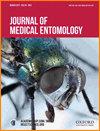Measuring local genetic variation in permethrin-resistant head lice (Phthiraptera: Pediculidae) from Buenos Aires, Argentina
IF 2
3区 农林科学
Q1 ENTOMOLOGY
引用次数: 0
Abstract
The cosmopolitan ectoparasite human head louse, Pediculus humanus capitis (De Geer)(Phthiraptera:Pediculidae), affects mostly school-aged children, with infestations reported every year mainly due to louse resistance to pyrethroids. One of the main resistance mechanisms of pyrethroids is the target site insensitivity (kdr), which is caused by single-nucleotide point mutations (SNPs) located in the voltage-sensitive sodium channel gene. In this study, we analyzed individual head lice toxicologically via the description of their susceptibility profile to permethrin and genetically through the genotypification of their kdr alleles as well as nuclear microsatellite loci. Lice were collected from 4 schools in the city of Buenos Aires, Argentina. The resistance ratios varied from 33.3% to 71.4%, with a frequency of the T917I kdr mutation of 87.31% and with 83.6% of the head lice being homozygous resistant to pyrethroids. Microsatellite data indicated that all the louse school populations had genotype proportions that deviated from Hardy–Weinberg expectations, with FIS > 0 reflecting a deficit of heterozygotes. Bottleneck analysis suggested that all louse school populations underwent a recent reduction in population sizes, while 3 of the 4 schools had gene flow values around 1, indicating ongoing gene flow among those schools. Our study suggests that school louse populations in the city of Buenos Aires may form a metapopulation, where each school represents a small population that undergoes extinction and recolonization processes under strong permethrin selection. This is the first multilevel analysis integrating toxicological, kdr-genotyping, and microsatellite data in human louse populations.测量阿根廷布宜诺斯艾利斯抗菊酯类头虱(Phthiraptera: Pediculidae)的地方遗传变异
世界性体外寄生虫人类头虱(Pediculus humanus capitis (De Geer))(Phthiraptera:Pediculidae)主要危害学龄儿童,每年都有关于虱子对拟除虫菊酯产生抗药性的报告。除虫菊酯的主要抗药性机制之一是靶位点不敏感(kdr),它是由电压敏感钠通道基因中的单核苷酸点突变(SNPs)引起的。在这项研究中,我们通过描述头虱对氯菊酯的敏感性特征,对其进行毒理学分析;通过对其 kdr 等位基因以及核微卫星位点进行基因分型,对其进行遗传学分析。从阿根廷布宜诺斯艾利斯市的 4 所学校采集了虱子。抗药性比率从 33.3% 到 71.4% 不等,T917I kdr 突变的频率为 87.31%,83.6% 的头虱对拟除虫菊酯具有同源抗药性。微卫星数据表明,所有虱子学校种群的基因型比例都偏离了哈代-温伯格预期,FIS > 0反映了杂合子的不足。瓶颈分析表明,所有学校的虱子种群数量最近都有所减少,而4所学校中有3所的基因流值在1左右,表明这些学校之间的基因流仍在继续。我们的研究表明,布宜诺斯艾利斯市的学校虱子种群可能形成了一个元种群,其中每所学校代表一个小种群,在菊酯的强烈选择下经历了灭绝和重新定殖的过程。这是首次在人类虱子种群中整合毒理学、kdr-基因分型和微卫星数据的多层次分析。
本文章由计算机程序翻译,如有差异,请以英文原文为准。
求助全文
约1分钟内获得全文
求助全文
来源期刊
CiteScore
4.60
自引率
14.30%
发文量
207
审稿时长
3-8 weeks
期刊介绍:
Journal of Medical Entomology is published bimonthly in January, March, May, July, September, and November. The journal publishes reports on all phases of medical entomology and medical acarology, including the systematics and biology of insects, acarines, and other arthropods of public health and veterinary significance. In addition to full-length research articles, the journal publishes Reviews, interpretive articles in a Forum section, Short Communications, and Letters to the Editor.

 求助内容:
求助内容: 应助结果提醒方式:
应助结果提醒方式:


